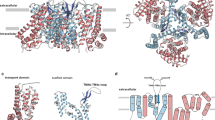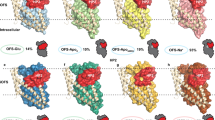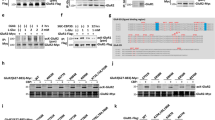Abstract
Excitatory amino-acid carrier 1 (EAAC1) is a high-affinity Na+-dependent l-glutamate/d, l-aspartate cell-membrane transport protein1. It is expressed in brain as well as several non-nervous tissues. In brain, EAAC1 is the primary neuronal glutamate transporter2,3. It has a polarized distribution in cells and mainly functions perisynaptically to transport glutamate from the extracellular environment2,3,4. In the kidney it is involved in renal acidic amino-acid re-absorption and amino-acid metabolism5,6,7. Here we describe the identification and characterization of an EAAC1-associated protein, GTRAP3-18. Like EAAC1, GTRAP3-18 is expressed in numerous tissues8,9. It localizes to the cell membrane and cytoplasm, and specifically interacts with carboxy-terminal intracellular domain of EAAC1. Increasing the expression of GTRAP3-18 in cells reduces EAAC1-mediated glutamate transport by lowering substrate affinity. The expression of GTRAP3-18 can be upregulated by retinoic acid, which results in a specific reduction of EAAC1-mediated glutamate transport. These studies show that glutamate transport proteins can be regulated potently and that GTRAP can modulate the transport functions ascribed to EAAC1. GTRAP3-18 may be important in regulating the metabolic function of EAAC1.
This is a preview of subscription content, access via your institution
Access options
Subscribe to this journal
Receive 51 print issues and online access
$199.00 per year
only $3.90 per issue
Buy this article
- Purchase on Springer Link
- Instant access to full article PDF
Prices may be subject to local taxes which are calculated during checkout




Similar content being viewed by others
References
Kanai, Y. & Hediger, M. A. Primary structure and functional characterization of a high-affinity glutamate transporter. Nature 360, 467– 471 (1992).
Rothstein, J. D. et al. Localization of neuronal and glial glutamate transporters. Neuron 13, 713– 725 (1994).
Rothstein, J. D. et al. Knockout of glutamate transporters reveals a major role for astroglial transport in excitotoxicity and clearance of glutamate. Neuron 16, 675– 686 (1996).
He, Y., Janssen, W. G. M., Rothstein, J. D. & Morrison, J. H. Differential synaptic localization of the glutamate transporter EAAC1 and glutamate receptor subunit GluR2 in the rat hippocampus. J. Comp. Neurol. 418, 255– 269 (2000).
Shayakul, C. et al. Localization of the high-affinity glutamate transporter EAAC1 in rat kidney. Am. J. Physiol. Renal Physiol. 42, F1023– F1029 (1997).
Peghini, P., Janzen, J. & Stoffel, W. Glutamate transporter EAAC-1-deficient mice develop dicarboxylic aminoaciduria and behavioral abnormalities but no neurodegeneration. EMBO J. 16, 3822– 3832 (1997).
Sims, K. D., Straff, D. J. & Robinson, M. B. Platelet-derived growth factor rapidly increases activity and cell surface expression of the EAAC1 subtype of glutamate transporter through activation of phosphatidylinositol 3-kinase. J. Biol. Chem. 275, 5228– 5237 (2000).
Hediger, M. A. & Welbourne, T. C. Introduction: glutamate transport, metabolism, and physiological responses. Am. J. Physiol. 277, F477– F480 (1999).
Hediger, M. A. Glutamate transporters in kidney and brain. Am. J. Physiol. 277, F487– F492 (1999).
Lin, C. G. et al. Aberrant RNA processing in a neurodegenerative disease: The cause for absent EAAT2 a glutamate transporter, in amyotrophic lateral sclerosis. Neuron 20, 589– 602 (1998).
Robinson, M. B. The family of sodium-dependent glutamate transporters: a focus on the GLT-1/EAAT2 subtype. Neurochem. Int. 33, 479– 491 (1998).
Bergles, D. E. & Jahr, C. E. Synaptic activation of glutamate transporters in hippocampal astrocytes. Neuron 19, 1297– 1308 (1997).
Bergles, D. E., Dzubay, J. A. & Jahr, C. E. Glutamate transporter currents in bergmann glial cells follow the time course of extrasynaptic glutamate. Proc. Natl Acad. Sci. USA 94, 14821– 14825 (1997).
Diamond, J. S. & Jahr, C. E. Transporters buffer synaptically released glutamate on a submillisecond time scale. J. Neurosci. 17, 4672– 4687 (1997).
Davis, K. E. et al. Multiple signaling pathways regulate cell surface expression and activity of the excitatory amino acid carrier 1 subtype of Glu transporter in C6 glioma. J. Neurosci. 18, 2475– 2485 (1998).
Conti, F., DeBiasi, S., Minelli, A., Rothstein, J. D. & Melone, M. EAAC1, a high-affinity glutamate transporter, is localized to astrocytes and gabaergic neurons besides pyramidal cells in the rat cerebral cortex. Cereb. Cortex. 8, 108– 116 (1998).
Sepkuty, J., Eccles, C. U., Lesser, R. P., Dykes-Hoberg, M. & Rothstein, J. D. Molecular knockdown of neuronal glutamate transporter EAAT3 produces epilepsy and dysregulation of GABA metabolism. Soc. Neurosci. Abstracts 23, 1484 (1997).
Lin, C. L. G. et al. Molecular cloning and expression of the rat EAAT4 glutamate transporter subtype. Mol. Brain Res. 63, 174– 179 (1998).
Furuta, A., Martin, L. J., Lin, C. L. G., Dykes-Hoberg, M. & Rothstein, J. D. Cellular and synaptic localization of the neuronal glutamate transporters excitatory amino acid transporter 3 and 4. Neuroscience 81, 1031– 1042 (1997).
Acknowledgements
We thank R. Huganir for the pRK5 vector; J. Sepkuty, R. Ganel, and W. Song for helpful suggestions and discussions; and L. Jin, C. Coccia and B. Kim for technical support.
Author information
Authors and Affiliations
Corresponding author
Supplementary information
Supplementary Information
Supplementary Information (PDF 14 kb)
Rights and permissions
About this article
Cite this article
Lin, Cl., Orlov, I., Ruggiero, A. et al. Modulation of the neuronal glutamate transporter EAAC1 by the interacting protein GTRAP3-18. Nature 410, 84–88 (2001). https://doi.org/10.1038/35065084
Received:
Accepted:
Issue Date:
DOI: https://doi.org/10.1038/35065084
This article is cited by
-
The NERP-4–SNAT2 axis regulates pancreatic β-cell maintenance and function
Nature Communications (2023)
-
Rapid Regulation of Glutamate Transport: Where Do We Go from Here?
Neurochemical Research (2022)
-
The Regulatory Role of Reticulons in Neurodegeneration: Insights Underpinning Therapeutic Potential for Neurodegenerative Diseases
Cellular and Molecular Neurobiology (2021)
-
Mutual regulation of JAG2 and PRAF2 promotes migration and invasion of colorectal cancer cells uncoupled from epithelial–mesenchymal transition
Cancer Cell International (2019)
-
Astrocytic JWA deletion exacerbates dopaminergic neurodegeneration by decreasing glutamate transporters in mice
Cell Death & Disease (2018)
Comments
By submitting a comment you agree to abide by our Terms and Community Guidelines. If you find something abusive or that does not comply with our terms or guidelines please flag it as inappropriate.



